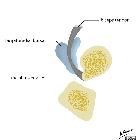Bursitis bicipitoradialis




Bicipitoradial bursitis refers to inflammation of the bicipitoradial bursa.
The bicipitoradial bursa surrounds the biceps tendon in supination. In pronation, the radial tuberosity rotates posteriorly, which compresses the bicipitoradial bursa between the biceps tendon and the radial cortex, which consequently increases the pressure within the bursa.
Epidemiology
It typically presents in adults and may be more common in males.
Clinical presentation
Patients often present with elbow swelling, pain, tenderness, redness, and limited movement.
Pathology
Most often results from repetitive mechanical trauma or overuse. Other less common causes include tuberculosis, synovial chondromatosis. and immunological complications of rheumatological disease.
Radiographic features
Ultrasound
There may be evidence of distention of the bicipitoradial bursa by fluid, which appears anechoic, or hypoechoic soft tissue. Nodular soft-tissue debris and small calcifications may be seen within the fluid. The distal biceps tendon should be evaluated for injury. Power Doppler imaging may show hyperemia and suggests active inflammation.
MRI
Features observed on different sequences include
- T1: homogeneous hypointense signal mass in characteristic location; associated tendinosis of biceps tendon, thickening and intermediate signal intensity at insertion
- T2: hyperintense flattened, oval, or round shaped cystic appearing mass that shows fluid signal intensity on all pulse sequences unless containing inflammatory debris or calcification +/- rice bodies in patients with rheumatoid arthritis
- STIR: as with T2 with more homogeneous fat saturation
- T1 C+ (Gd): may demonstrate thin rim enhancement after gadolinium administration and homogeneous low central signal intensity
Treatment and prognosis
Management options include
- acute: rest, antibiotics, nonsteroidal antiinflammatory drugs, and aspiration of infected fluid
- chronic: splinting and removal of foreign bodies
Differential diagnosis
General imaging differential considerations include
- biceps tendon tear or tendinosis
- posterior elbow dislocation
- osteochondritis dissecans of the capitulum
- radial head fracture
- other causes of antecubital mass, e.g. lipoma, hematoma, neuroma
Siehe auch:
und weiter:

 Assoziationen und Differentialdiagnosen zu Bursitis bicipitoradialis:
Assoziationen und Differentialdiagnosen zu Bursitis bicipitoradialis:

